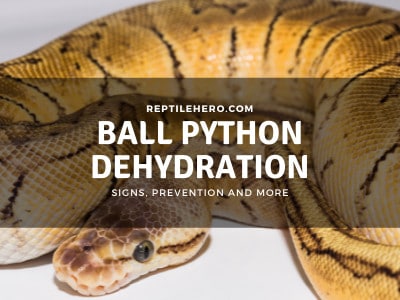Can You Take Your Ball Python Outdoors?
As you went walking outside, you saw people accompanied by their cats and dogs. You’ll probably contemplate how boring owning a snake is. Then you came up with an idea…what if I take my ball python outside? Then you ask yourself again, is it really safe?
Ball pythons can be taken outdoors. Despite not being necessary, this can be beneficial for them. However, ball pythons should be monitored and placed in a known environment in order to avoid being attacked, getting sun-damaged, and being affected by chemicals and pesticides that can be found on public ground parks.
Ball pythons are hardy and are essentially adapted to surviving in the wild. But for captive-bred ball pythons, is it okay to bring them outdoors? Why would you even want to do this? Find out more as you read below!

Do You Need to Take Your Ball Python Outside?
Taking a ball python outside is not a priority when keeping them in captivity, but if done, it can give them some benefits like 1) enrichment, 2) sunlight, and 3) ventilation
Enrichment
Just an hour of moving outside can help a ball python’s metabolism. Bringing them outside can also stimulate their brain especially when they are allowed to explore a natural environment.
Compared to being enriched in their enclosure, bringing them outside is sometimes better because of the amount of space it provides. This will stimulate your ball python’s brain even more
One act that shows a ball python is stimulated is called “scoping”. This indicates their curiosity when placed in a new environment.

Providing enrichment through their enclosure is also good but this may cost more. What this means is that their enclosures must have a larger floor and height space.
For adult ball pythons I would recommend the minimum size like this tub for rack systems on Amazon. A good quality plastic tub with the minimum measurements for an adult ball python.
Though some reviews say that there are detached plastic pieces so make sure you have a trusted shipment company.
And for people that would like to keep their ball python in a more enriching space, I would recommend an enclosure like this. It is very easy to set up but like any other glass enclosure, there may be damage if not shipped properly.
Sunlight
Sunlight can help a ball python’s digestion and can give Vitamin D[1]. But in the wild, ball pythons are found in burrows during the day so minimal sunlight reaches them.
Regarding exposure to the sun, I recommend letting them out in the sun for at least 10 minutes and up to 30 minutes. Ball pythons are typically inside their burrows in the wild during the daytime, so long exposure to the sun may stress them out.
Providing a UVB light for their enclosure is not a must. But if you decide to get one.
It is the perfect intensity for a ball python, but turn it off during the nighttime. When handled improperly, the lens part of the product might be damaged in the shipping.
Ventilation
Bringing a ball python outside can give them good ventilation. This will allow them to breathe better which can improve their respiratory health.
Ball pythons are often kept in racks and in an enclosed environment with not much ventilation. This is fine since their burrows in the wild do not provide a lot of ventilation either.
Ventilation may also vary in different countries. Those in tropical countries might need more ventilation and those in temperate countries may need less to keep the humidity up in certain seasons.
Risks in Taking Your Ball Python Outside
It is hard to find the perfect environment for a ball python, most of the time, outdoor space may come with risks that may affect your snake. Some risks are 1) predators, 2) chemicals, 3) temperature, and 4) parasites
Predators
Ball pythons, due to their relatively small size compared to big snakes, have natural predators. In the wild, young ball pythons tend to be preyed upon by large frogs, large insects, and even other snakes. Adults can even be preyed upon by hyenas, birds of prey, lions, and leopards.
But if you are just taking your ball python to your lawn, in your garden, or somewhere near the vicinity of your home, you may not encounter the animals mentioned. But be wary of the following animals as they can prey on or attack a ball python
Birds
These are one of the most common predators any snake, including a ball python, has in the wild. Be vigilant with your surroundings and see first if there are no eagles or hawks that may be flying around the area. Even adult ball pythons are not safe from these predators.
Cats
Also a potential threat to a ball python, cats can use their sharp claws and fangs to injure or even worse, kill your snake. Wild cats or even street cats can also be found preying on smaller snakes. That is why if you have a baby ball python it is wise to keep them away from your cats.
Dogs
Dogs can be vicious around ball pythons, especially because ball pythons are defenseless compared to other big snakes or venomous ones. Dogs won’t essentially eat your snake, but they can injure a ball python quite badly and may end up killing it.
Chemicals
Harmful chemicals found on the grass, soil, water, or smoke may be a potential threat to a ball python. Some common chemicals that can be encountered are 1) insecticide, 2) toxic bodies of water, and 3) harmful gases.
Insecticides
These are mainly found on grass or vegetation and are very harmful to your ball python. Insecticides in the form of smoke/vapor are also toxic to them.
Chemicals like DDT, aldrin, dieldrin, toxaphene, and heptachlor are highly toxic to snakes [2]. There are other harmful chemicals but these are the most common in insecticides.
Toxic body of water
Be wary of letting your snake soak in some random pond or body of water as it may contain the following chemicals: lead, arsenic, chlorine, and mercury. Bodies of water near factories and industrial buildings are often toxic too.
Harmful Gases
Smoke either from cigarettes, cars, or factories can be harmful to your ball python, especially in long exposures. Which will then result in respiratory issues.[3]
Ball pythons have no specific immunity to any toxic gases. So if it is bad for you, then it is certainly worse for your snake.
Temperature
Ball pythons cannot tolerate extreme cold and hot temperatures. The lowest recommended temperature would be 75F and the highest should not be over 95F.
If the temperature lowers between 74F and 65F, a ball python’s body will shut down and cause them to hibernate. Low temperatures may cause them to be sluggish and can eventually lead to respiratory problems.
If the temperature goes higher than 95F, ball pythons will overheat causing them to be very stressed. If the temperature goes beyond the 100F mark, they will encounter burns.
Be wary of the material of the ground you allow your ball python to crawl. Stones, metals, asphalt, and even regular soil can conduct a lot of heat which can burn the underbelly of your snake.

Parasites
Parasites can be found inside the snake or on its skin. They can cause a variety of symptoms, from discomfort to improper bowel movement, they can even cause death to ball pythons. They are commonly transmitted from other animals, or from food and water intake.
If you took your ball python outside, you should be aware that there are rare instances they can come in contact with the following parasites[4]
Snake mites
Snake mites are abundant in nature and most snakes that are in the wild have them, especially terrestrial and arboreal snakes. They can also be acquired from substrates and other reptiles.
After you take your ball python outside, make sure to thoroughly check for any mites then clean your snake. You can also give them a warm soak for at least 10 minutes before putting them back in their enclosure.
In case of a mite infestation, you must first quarantine the snake and give it an anti-mite-treatment. That way, after the initial mites are removed, eggs will also perish due to the treatment.
Parasitic worms
Parasitic worms come in many shapes and sizes. These are internal parasites and they infest different organs of a snake. They are often transmitted through prey and water.
I advise that you should supervise your snake so it may not accidentally drink in a random body of water or eat wild prey. Symptoms of internal parasites may vary but some are:
-Diarrhea or abnormal stools
-Loss of appetite
-Sudden weird movements (unusual movements that are not inborn)
-Regurgitation and vomiting
If the majority of these symptoms show up, you should first consult your exotic veterinarian before doing any first aid measures.
What To Check Before Taking Your Ball Python Outdoors (With Tips)
Before taking a ball python outside, there are factors that should be kept in mind. These are 1) age, 2) condition, 3) weather, 4) location and 5) duration.
Age
In captivity, the recommended age for a ball python to be taken outside is to be at least one year old. They are juvenile at this stage and have a tougher body and skin compared to hatchlings
Tip: To be more exact, a ball python must weigh at least 500 grams before you can take them outdoors.
Fun fact: Ball pythons are fragile during the first two weeks of their life. In the wild, a female ball python will give warmth and protection to her offspring for at least two weeks. After that, they are left on their own.
Weather
The best weather for a ball python is sunny, yet cloudy weather. Too much sun or rain can cause bad temperature gradients to a ball python.
Ball pythons are not really a basking-type of reptile. They usually hide in their burrows during the day. So take note that very hot weather is bad for them (Higher than 95F)
Ball pythons can tolerate somewhat low temperatures since they hunt at night. But temperatures that are too low can cause respiratory diseases (Lower than 75F)\
A humidity level of 65-75% is recommended and this should allow your ball python to shed its skin properly.
Location – Best and Worst Places to Bring a Ball Python
The best outdoor locations for your ball python are private areas like gardens and lawns. Public places are not recommended due to crowds and certain laws. Locations with rough surfaces are also not recommended.
Gardens and lawns are the most suitable location for a ball python’s outdoor enrichment. Grass and shade can create the perfect temperature gradient for your snake

Grass also insulates heat preventing burns on the snake’s underbelly. They are also quite visible in a green environment so you can keep an eye on them.
Tip: You should check first if a planted environment has insecticides(often harmful to snakes). Also, check if the grass is too dry and hard to prevent cuts to the snake’s underbelly.
Public places are not recommended for your ball python because they can be stressed out by crowds and they have the risk of being attacked by another pet. Certain places also ban reptiles in public.
There are also some people that have phobias to snakes which are Ophidiophobia and Herpetophobia (Fear of all reptiles). So being discreet is a good course of action when you take your ball python out in the public.
The only times I recommend bringing your ball python in public is during educational purposes in schools or in reptile shows/conventions (with legal permission of course).
Tip: If you are planning to bring your ball python in the public, I recommend that you bring with you a black tub and only allow interaction for a maximum of 15 minutes.
Places with rocky and sharp terrains are also not recommended to prevent your ball python from getting its underbelly cut and getting its scales removed.
Condition
A ball python must be in a good condition to be able to go outside. There are 4 things to observe: 1) temperament, 2) shedding, 3) newly-fed, and 4) illness.
Temperament is very important to look for when taking a ball python out. Snakes that are unusually defensive and in a bad mood must not be disturbed.
Shedding is the process where a snake expends its energy on making sure its old skin comes off. If your ball python is in the process of shedding do not disturb it to prevent further stress.
Tip: I suggest not taking your ball python outside a day or two after their shedding. Their skin is very soft at this stage and can easily be cut or bruised.
A newly fed ball python is not to be handled, much worse, taken outdoors. You should wait for at least 48 hours to take your ball python out.
Tip: After 48 hours, taking a newly fed ball python outdoors can help it digest its food properly.
Snakes with illness/es must not be taken outdoors at all costs unless advised by an exotic veterinarian.
Frequency
It is recommended to take your ball python out at least 1-2 times per week for at least 10 minutes. These can be up to 30 minutes but must be monitored closely.
This frequency is healthy enough for a ball python to get the benefits and avoid being stressed out. Because ball pythons do not necessarily need interaction with humans, unlike other pets like cats and dogs.
Can You Leave Your Ball Python Roaming in Your Room?
Though it is not recommended, ball pythons can be left roaming in a room as long as there are no chances of escape. Ball pythons free-roaming in a room can have a better metabolism and enrichment compared to ones in an enclosure.
The main benefit of letting a ball python free roam in a room is having the capability to digest their food faster through movements. Another benefit is enrichment, from climbing things and exploring different spots in the room.
The main risk is the possibility of escape. Ball pythons can fit through most holes their head can fit in. With this, the possibility of being stuck and injured is also very high.
In my experience, I already had my ball python, choco, escape from his enclosures. The first one is when I accidentally left the tub open (his temporary home after I got him).
The second one is when I forgot to lock his glass enclosure. Yes, for some reason he was able to open the sliding glass.
But how did I find him? First I blocked all the escape routes and holes he might get through. Next, I lifted all furniture and check its insides.
For his first escape, I found him in a crack on our wall which I carefully pried him out of. I put oil in his scales so he can be pulled easily then, I tried to spray water on him to coax him out of there. Thankfully he just lost a few pieces of scale which he eventually grew back.
For his last escape, I found him peaking out on our washing machine’s pipe. At first, we are wondering why there seems to be a blockage on the pipe then we saw him peaking out. So the first thing I did was to fill out the pipe with water to force him to come out.
Next, I prepared a noose and then waited for an opportunity for him to peak his head fully, then I snatched his head with the rope and gently pulled him out while using my other hand to pull his body.
After this incident, I learned my lesson and never underestimated the escaping capability of a snake. In general, they can fit through any hole about the same size as their head.
Further Questions
What is better for ball pythons? UVB or Sunlight?
Natural sunlight is better for ball pythons because not only are they getting vitamin D but their brains are also getting enriched and stimulated due to the environment outdoors. UVB is also good but not required for a ball python enclosure.
Can the sun rays damage the eyes of ball pythons?
Even though ball pythons are mostly nocturnal animals, most morph’s eyesights will be fine in regards to the sun rays. Though, albino morphs can get their eye damage because of being sensitive due to albinism.
Can my ball python get sunburned?
Ball pythons, like most reptiles, have scales that protect their inner skin from sunburn. These scales also help keep moisture to prevent overheating while basking. A reptile can get sunburned but they’ll die from overheating first before they reach getting a sunburn.
Summary of Can You Take Your Ball Python Outdoors?
Ball pythons can be taken outside. Taking your ball python out can provide benefits like enrichment, sunlight, and ventilation. This can contribute to making their quality of life even better.
Taking a ball python outdoors also have potential risks like predators, chemicals, temperature, and parasites. When taking a ball python out factors to be considered are their age, condition, weather, location, and duration.
References
[4] https://actavetscand.biomedcentral.com/track/pdf/10.1186/1751-0147-53-33.pdf







